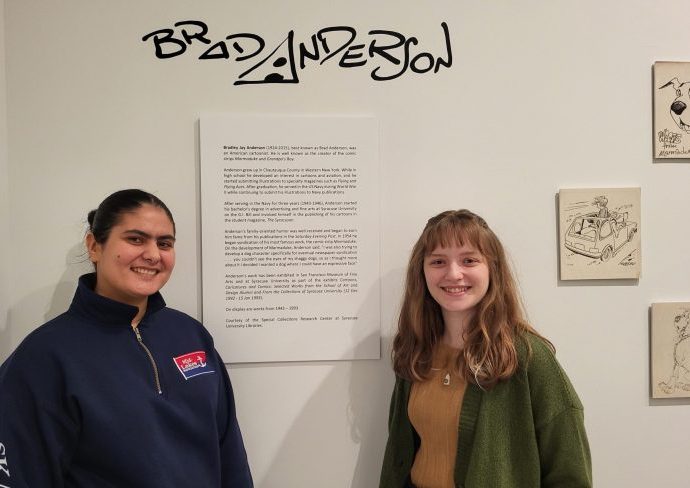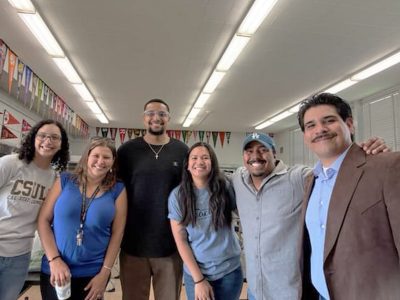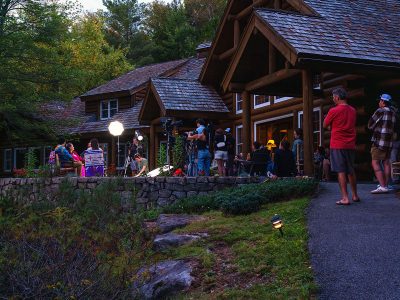NVRC Gallery Exhibition Provides Graduate Students With Curatorial Experience
A new exhibition co-curated by three museum studies graduate students represents multiple collaborations across the University. It connects current students and alumni; pairs the College of Visual and Performing and Arts (VPA) and the National Veterans Resource Center (NVRC); and uses treasured art from the Syracuse University Libraries archives to create an interesting new military-themed public display.
“Paper Trail: Works by Veteran Photographers, Cartoonists and Sketch Artists,” is on display at the National Veterans Resource Center Gallery, which is managed by VPA’s creative arts therapy program, through Friday, Aug. 2.
Many of the images are from three cartoonist collections held at the Special Collections Research Center. Featured are works by Mort Walker (“Beetle Bailey”), Brad Anderson (“Marmaduke”) and Dave Breger (a World War II cartoonist). Other materials are by Alan Dunn and former students of the military visual journalism program at the Newhouse School of Public Communications: Kenny Holston, Preston Keres, Pablo Piedra, Ethan Rocke and Marianique Santos.
The co-curators, graduate students Ohoud Ibrahim Alfadhli, Upneet Kaur Mair and Katelyn Marie Miller, have all worked on various aspects of the exhibit as NVRC Gallery curatorial assistants.

Jennifer DeLucia, assistant professor and chair of creative arts therapy, has guided the students through the project, which includes cartoons, photography and sketches that convey the complexities of the veteran experience. “As co-curators, students are empowered to take an active role in shaping the narrative and design of the exhibitions,” DeLucia says. “The interdisciplinary partnership between the art therapy and museum studies programs within VPA creates opportunities for unique dialogue as multiple perspectives inform the curatorial work, and students add fresh ideas and a great level of energy and enthusiasm.”
The experience also provides a unique interdisciplinary and experiential learning opportunity. “They are exposed to military culture and history, and that knowledge of military-connected communities will carry with them as they transition into new roles when they graduate, [helping them] address the miliary-civilian divide,” DeLucia says.
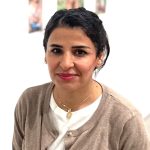
Co-curating the exhibit helped Alfadhli, an international student from Saudi Arabia, better understand the administrative functions of developing an exhibit, such as making appropriate legal arrangements for the loan of the art and copyright issues, she says. She also enjoyed delving into the archives to select exhibit items. “It allowed me to explore the artists’ works, sketches and correspondence, yet it was also challenging because I encountered numerous pieces that deserved to be exhibited.”
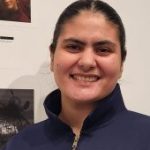
Mair, who is from India, says she enjoyed the installation process most. “It can be a bit exhausting, but the process is what I like about it, and once the exhibition is up, the satisfaction of doing it feels good,” she says. Mair, who has a master’s degree in fine arts, finishes the museum studies master’s program this spring. She wants to work at major museums in New York City as a curator or collection manager.
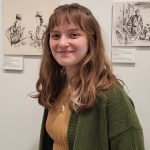
Miller hails from Gettysburg, Pennsylvania, which she calls “a place where museums, history and community engagement rule every major endeavor.” She adds: “I have embraced that perspective in both my undergraduate degree and my graduate career here.”
Miller used software to plot the exhibits in the gallery space, inputting artwork dimensions to develop an accessible and efficient design, an aspect of exhibition work that she particularly enjoyed. “Working on this exhibition from concept to installation has been a valuable exercise in collaboration and exhibition research and design. This space is an ideal environment for developing my skills as a museum professional, and I hope that ‘Paper Trail’ conveys this effort to its visitors,” she says. Miller wants to work in an institution that provides the community with learning resources, such as a national park, library or museum.
“The NVRC was intentionally designed to nurture interdisciplinary programming to advance the social, economic and wellness concerns of veterans and their families,” says J. Michael Haynie, vice chancellor for strategic initiatives and innovation and executive director of the University’s D’Aniello Institute for Veterans and Military Families. “Our collaboration with VPA at the NVRC Gallery is a unique example of Syracuse University’s commitment to being the best place for veterans, and I encourage the campus community to visit this impressive exhibit.”
